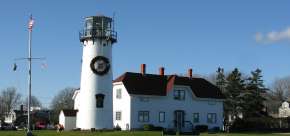2. Chatham Lighthouse


Considered the iconic landmark of the town, the Chatham Light stands 48 feet tall and 80 feet above sea level overlooking the infamous Chatham Bar. It is one of the few lighthouses in America that still operates 24 hours a day.
The Chatham Lighthouse station was first established in 1808, the second to be built on Cape Cod. The rotating beacon you see today did not exist back then. In order to distinguish the Chatham Light from the Highland lighthouse at North Truro, when seen from out on the Atlantic, Chatham was built with two lights - two full light towers, 70 feet apart. Chatham light was known for many years as “Twin Lights”, and is still known by this name by the local fishing community.
The original Twin Lights of 1808, and their 1841 replacement towers, were located substantially to the east of the current lighthouse. The approximate location of these original lighthouses is shown on the eTour map by pin 2a. At that time, the towers were well over 200 feet back from the bluff, which means the bluff’s edge was located somewhere close to the present waterline on the beach. The location of the first Twin Lights was known as “James Head” at that time, suggesting that the land projected out at that point, with perhaps little beach area below the bluff. It is likely that years of erosion have removed the “head” that gave “James Head” its name. In the 1870’s the erosion of the bluff had become almost 30 feet per year. In 1877, when the bluff had moved to within 50 feet of the towers, the decision was made to build two new light towers at the current location.
In 1923, the Twin Lights were separated. New rotating lenses made the Twin Towers unnecessary; lighthouses were then and now recognized by the interval of their rotating beacon. Even though the lenses rotated, however, the lights continued to burn kerosene. The North Tower was moved to Eastham to become Nauset Light, replacing the three lights that had been known as the “Three Sisters”. The original site of the north tower can be seen on the on the grounds of the Chatham Coast Guard Station, with the concrete base currently home to two “Admiralty” style anchors.
Until 1939, all lighthouses were part of the U.S. Lighthouse Service, a distinct United States department. In 1939, the U.S. Coast Guard assumed the responsibilities of the Bureau of Lighthouses. Chatham Lighthouse was once again updated with state of the art technology; an electric motor replaced the clockwork drive used to rotate the light, and the light itself was electrified.
In 1969, the light’s Fresnel lens was replaced with modern technology. This lens had been installed in 1857, when the Twin Lights still burned lard oil. The old lantern housing and Fresnel lens are now on display on the grounds of the Chatham Historical Society’s Atwood House Museum, not far from Chatham Light, and site #20 on this eTour. That lens is lit whenever the museum is open.
The lighthouse stands today as part of an active duty Coast Guard Small Boat Station, with a primary mission of Search & Rescue, responsible for the safety of the local fishing fleet and recreational boating community. In 1994, the local U.S. Coast Guard Auxiliary flotilla 11-1 assumed the responsibility as the “Keepers of the Light”. Flotilla 11-1 has volunteered countless hours keeping up the light and conducting weekly tours for the public during the summer.
Some statistics about Chatham Lighthouse:
- 44 steps to the top landing
- 2.8 million candlepower (approximately 100 times the brightness of each of the Twin Lights when they burned kerosene)
- 2 flashes every 10 seconds
- Can be seen for 24 Nautical Miles (27.6 land miles)
 Prev
Prev